theartsdesk in Stavanger: A touch of Fröst | reviews, news & interviews
theartsdesk in Stavanger: A touch of Fröst
theartsdesk in Stavanger: A touch of Fröst
Swede co-hosts chamber groups in striking venues around Norway's amiable port
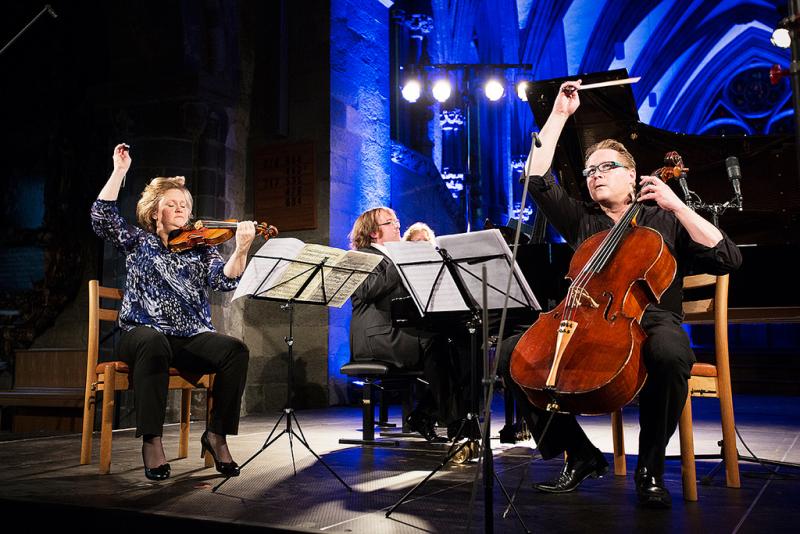
Three great pianists, one of the world’s top clarinettists and two fine string players in a single concert: it’s what you might expect from a chamber music festival at the highest level. What I wasn’t anticipating on the first evening in Stavanger was to move from the wonderful cathedral to an old labour club up the hill, now a student venue with two halls, for a late-night cabaret and hear five more remarkable performers.
Such is the free and easy way you come across top quality in unexpected formations at Stavanger. A lot of it has to do with the boundary-pushing of the clarinettist in question, Swede Martin Fröst, co-director of the 22-year-old International Chamber Music Festival since 2010 with Norwegian and relative newcomer Christian Ihle Hadland, one of the pianists in that first concert. Stavanger may not at present welcome the kind of featured composers who helped to make it such a big name in the early years, guided by cellist Truls Mørk and oboist Gregor Zubicky and featuring the likes of Lutosławski, Penderecki, Crumb, Dutilleux and Lindberg, but that liberates its participants to concentrate on other aspects.
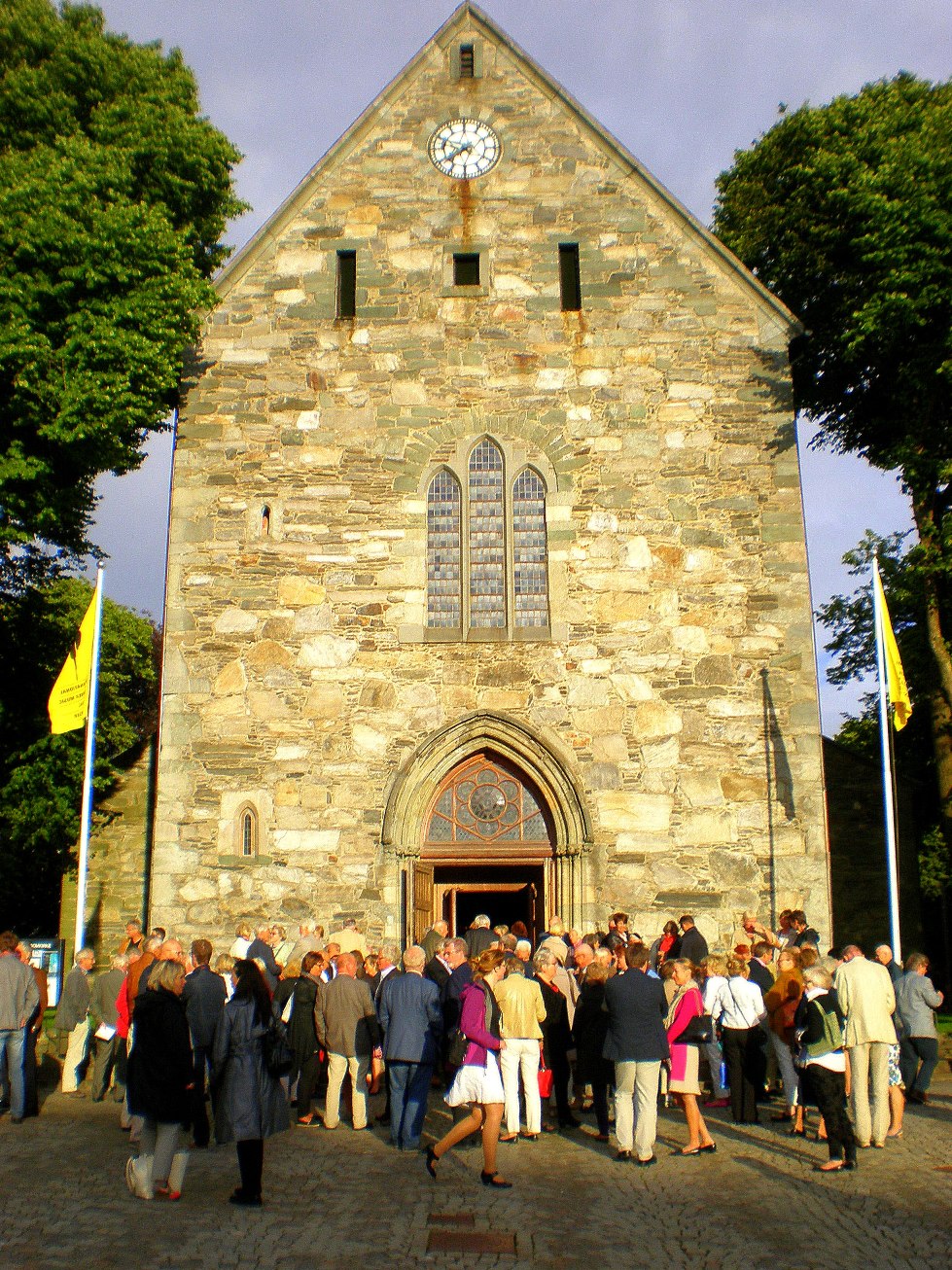 The priority now is to focus on the chance to play the great works of the chamber repertoire with top colleagues, who spend much of their time giving masterclasses at the International Summer Academy. As Zubicky, who still presents many of the concerts so charmingly, points out, musicians lead lonely lives, flying all over the world for concerts with orchestras and conductors they may never see again.
The priority now is to focus on the chance to play the great works of the chamber repertoire with top colleagues, who spend much of their time giving masterclasses at the International Summer Academy. As Zubicky, who still presents many of the concerts so charmingly, points out, musicians lead lonely lives, flying all over the world for concerts with orchestras and conductors they may never see again.
At the same time chamber music becomes ever less in demand, outside the Wigmore Hall’s hallowed sanctum, and the festival is its best chance these days. It couldn't have a quieter or more attentive audience - not at all, they proudly tell me, like the fidgety folk up in Bergen; if someone develops a cough, as I witnessed on the first evening, she (in this case) or he goes out.
This, then, is the musicians’ chance to cement the bonds of friendship just by playing. And I don’t know whether it’s Fröst’s impulsive, intuitive personality and the fires beneath Hadland’s polished, even reserved outward character, but the players I saw this year mostly had the sparks of unpredictability and wildness. Perfect for the theme of “No Strings Attached”, the spirit of the dance.
Very well, so we have mini-festivals of this sort where top players gather equals around them, often in their own village church, all round Britain. What makes this one special? The setting, of course, is paramount: Stavanger, with the ever-changing scene of its central harbour, the old whitewashed wooden houses spreading up the hill on one side and the old Valberg Tower dominating the livelier shops and eateries on the other, is a town big enough to let the festival events make their mark on it.
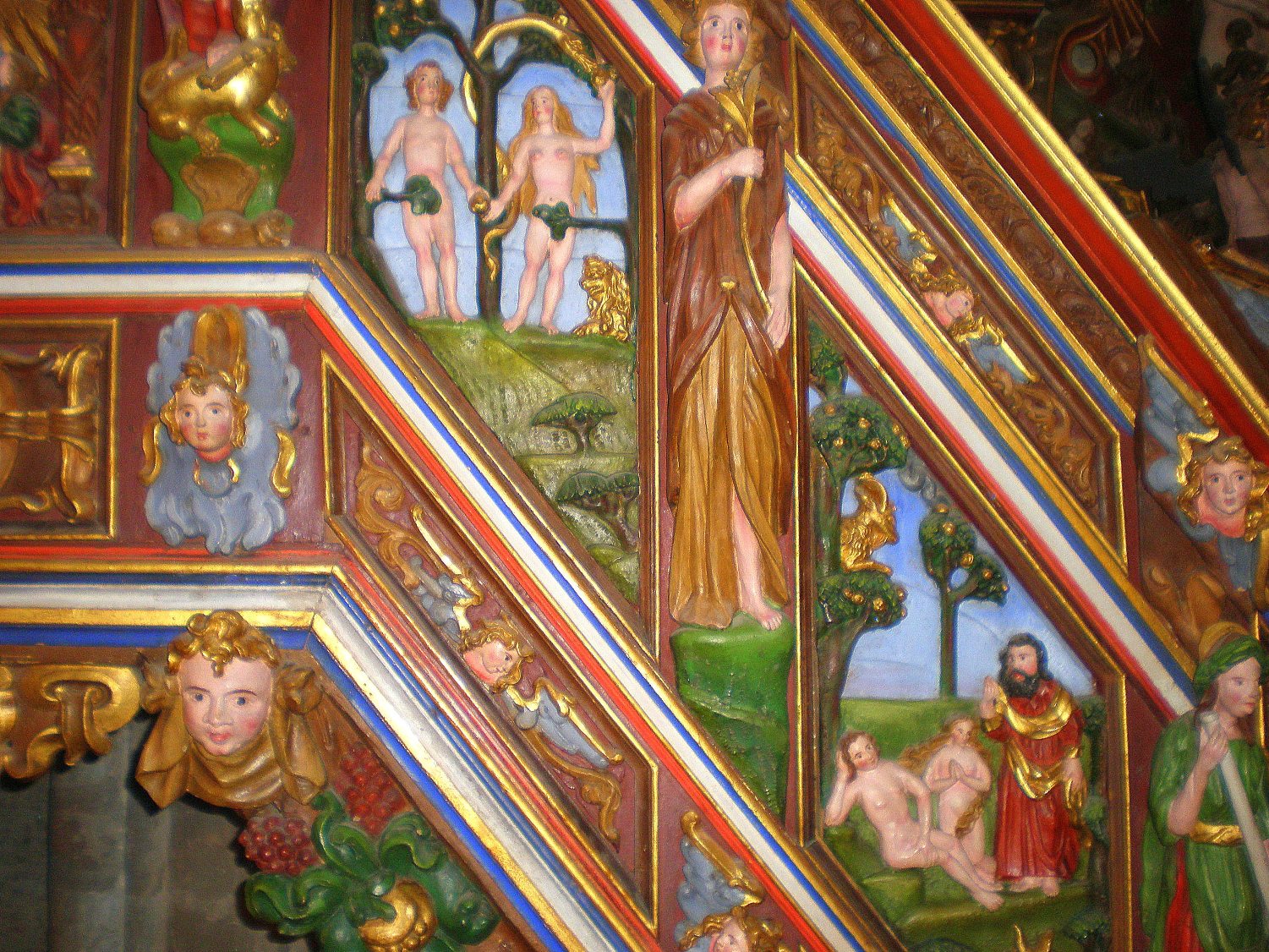 Core is the cathedral, with its Norman nave begun in 1125 and its Gothic chancel (crowds outside the west door on the first night pictured above). Concerts take place on a platform in between, alongside the gaudy and delightful pulpit carved by the Scot Andrew Smith in the 17th century (Adam and Eve scenes depicted above) with the chancel illuminated purple behind the players. The first dazzle began here with Polina Leschenko, protégée though never pupil of Martha Argerich who’s played at the festival. Ignorant of that fact as her fingers flew over the keyboard, seeming to hardly touch it, I was reminded of the impulsiveness of Khatia Buniatishvili, another of Argerich’s younger generation phenomenons.
Core is the cathedral, with its Norman nave begun in 1125 and its Gothic chancel (crowds outside the west door on the first night pictured above). Concerts take place on a platform in between, alongside the gaudy and delightful pulpit carved by the Scot Andrew Smith in the 17th century (Adam and Eve scenes depicted above) with the chancel illuminated purple behind the players. The first dazzle began here with Polina Leschenko, protégée though never pupil of Martha Argerich who’s played at the festival. Ignorant of that fact as her fingers flew over the keyboard, seeming to hardly touch it, I was reminded of the impulsiveness of Khatia Buniatishvili, another of Argerich’s younger generation phenomenons.
 Leschenko (pictured right) marked my first and last experiences of the first three days, and it was hardly the fault of cultured cellists István Várdai in Chopin’s Introduction and Polonaise Brillante and Jan-Erik Gustafsson in Rachmaninov’s great sonata if you couldn’t take your eyes off the pianist; but then both composers were more in love with the keyboard, too. Leschenko hovered on the brink of audibility with another soloist of compelling physical expressiveness, Fröst himself, signing in mysteriously with Berg’s Four Pieces Op. 5.
Leschenko (pictured right) marked my first and last experiences of the first three days, and it was hardly the fault of cultured cellists István Várdai in Chopin’s Introduction and Polonaise Brillante and Jan-Erik Gustafsson in Rachmaninov’s great sonata if you couldn’t take your eyes off the pianist; but then both composers were more in love with the keyboard, too. Leschenko hovered on the brink of audibility with another soloist of compelling physical expressiveness, Fröst himself, signing in mysteriously with Berg’s Four Pieces Op. 5.
There was humour and plenty of wry audience wrong-footing from that mighty Macedonian Simon Trpçeski in Liszt’s Second Hungarian Rhapsody; I must have heard it countless times in the best of all piano cartoons, Bugs Bunny’s Rhapsody Rabbit, but never live. Is it too much of a killer to place at the end of a full recital? The sweat that poured off note-perfect Trpçeski suggested it might be. Finally the tone of Marianne Thorsen, the Nash Ensemble’s Norwegian guiding light and a perfect soloist in her own right, soared in the wonderful, never over-reverberant cathedral – for which, essentially, read church, for it’s not a big one – alongside Gustafsson and Hadland, who made much of the chromatic strangenesses in the central movement of Smetana’s Piano Trio.
The surprise I mentioned was to rush in the pouring rain – after an interval of strong evening sunshine – to the former cinema called Folken, where I was expecting cabaret business as usual. It clearly wasn’t, right from the start, as Norwegian chanteuse (and trained mezzo) Tora Augestad and her quartet Music for a While launched into stylish jazz arrangements of John Dowland. Clearly the instrumentalists were no ordinary support group. Accordionist Stian Carstensson, according to my vivacious companion the Oslo-based critic Mona Levin, is an outstanding stand-up comedian and plays “a hundred other instruments”; his wry manipulation of several oddities and his virtuoso fugal whistling proved the point.
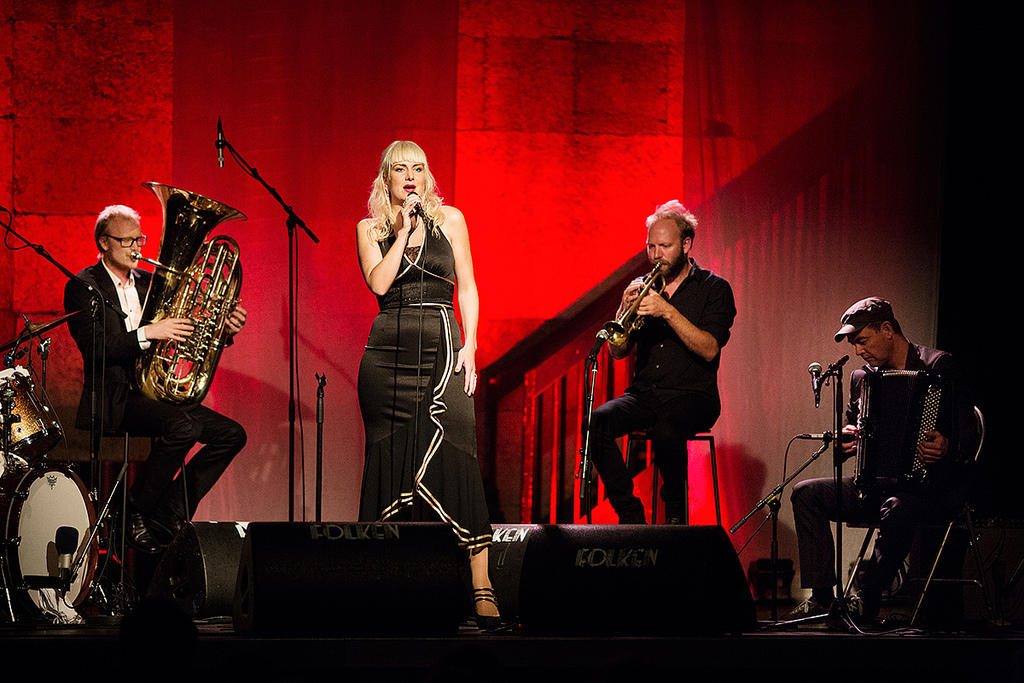 Cool Mathias Eick is a born jazz trumpeter, tuba player Martin Taxt had his moments in the sun and we heard a whole range of often subtle percussion from Paul Hausken (the only member of Music for a While not depicted right). Augestad’s pitch-perfect higher register was joined by quite a few other tones and sounds in some of the best Weill performances I’ve heard, chiefly an unsurpassable arrangement of "Surabaya Johnny". I wanted the Weill CD, and later bought it from the delightful lady who runs the festival stand and a famous music shop in nearby Sandnes (more of her anon). As for the cabaret, the barman downstairs when I finally took a break from Carstensson’s (to me) unfathomable Norwegian chat was amiably perplexed as to why no one had budged to come out for drinks during the performance.
Cool Mathias Eick is a born jazz trumpeter, tuba player Martin Taxt had his moments in the sun and we heard a whole range of often subtle percussion from Paul Hausken (the only member of Music for a While not depicted right). Augestad’s pitch-perfect higher register was joined by quite a few other tones and sounds in some of the best Weill performances I’ve heard, chiefly an unsurpassable arrangement of "Surabaya Johnny". I wanted the Weill CD, and later bought it from the delightful lady who runs the festival stand and a famous music shop in nearby Sandnes (more of her anon). As for the cabaret, the barman downstairs when I finally took a break from Carstensson’s (to me) unfathomable Norwegian chat was amiably perplexed as to why no one had budged to come out for drinks during the performance.
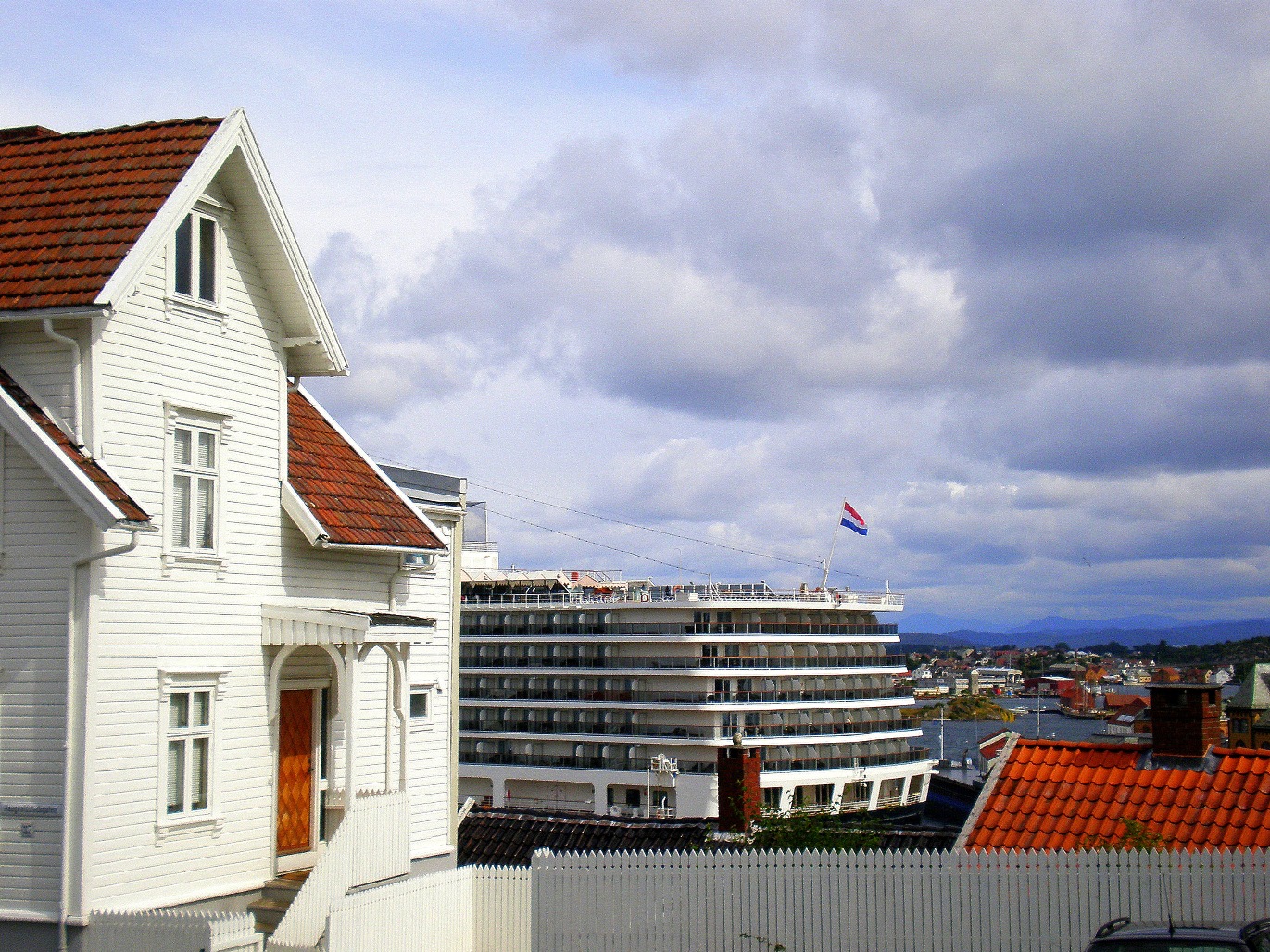 Tuesday morning was free for exploring the many upmarket villas on the top of the hill, winding down to the harbour through the lovely old town. Much visited it may be by tourists from the boats, but this is a residential district with no tacky shops, as it has been since its salvation from the developer’s chop in 1975. How surreal to see the funnel of a cruise liner over miniature roof tops and winding cobbled streets.
Tuesday morning was free for exploring the many upmarket villas on the top of the hill, winding down to the harbour through the lovely old town. Much visited it may be by tourists from the boats, but this is a residential district with no tacky shops, as it has been since its salvation from the developer’s chop in 1975. How surreal to see the funnel of a cruise liner over miniature roof tops and winding cobbled streets.
Lunchtime meant a date with the former harbour authority building on the Skanse quay, Skur 2, now a recital venue with big windows looking out over the islands and the passing boats.
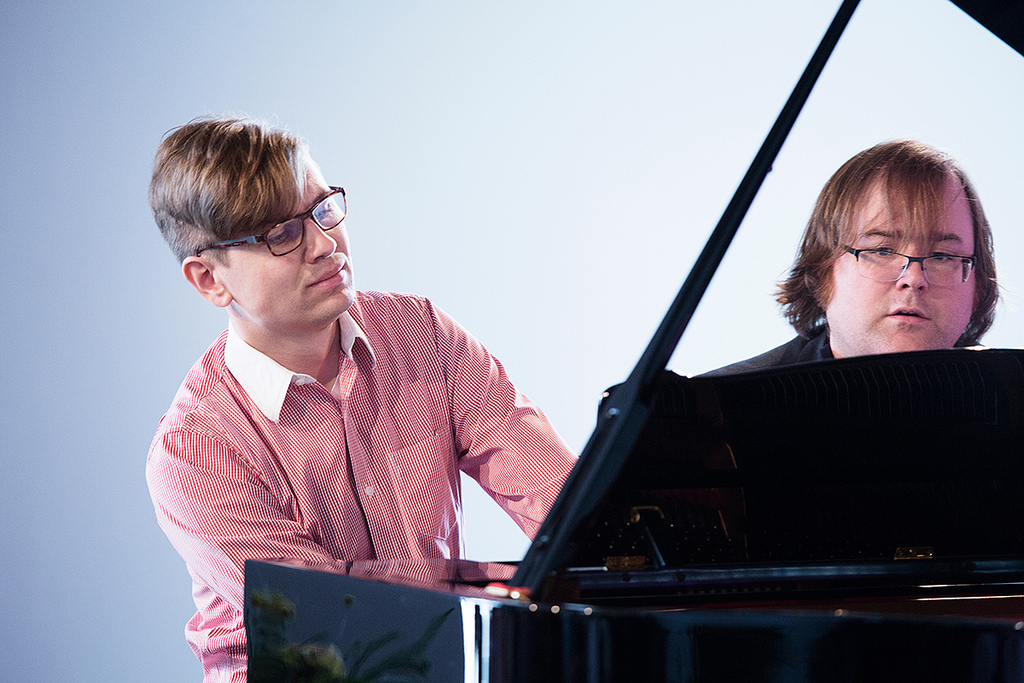 Here we made the acquaintance of idiosyncratic young Icelandic pianist Víkingur Ólafsson (pictured with Hadland right), Björk collaborator and champion of new music, who escaped easy categorization as he slipped from Shostakovich’s Fantastic Dances into Grieg’s four-hand arrangements of two discarded symphonic movements with Hadland and Bloch’s Hebrew Suite with Berlin Philharmonic principal viola and former Jerusalem Quartet member Amichai Grosz. The top music of the recital, though, belonged to hyper-sophisticated Russian violinist Valeriy Sokolov and Trpçeski in the Debussy Violin Sonata, both of its outer movements reaching genuinely surprising conclusions given the players’ masterly sleights of hand.
Here we made the acquaintance of idiosyncratic young Icelandic pianist Víkingur Ólafsson (pictured with Hadland right), Björk collaborator and champion of new music, who escaped easy categorization as he slipped from Shostakovich’s Fantastic Dances into Grieg’s four-hand arrangements of two discarded symphonic movements with Hadland and Bloch’s Hebrew Suite with Berlin Philharmonic principal viola and former Jerusalem Quartet member Amichai Grosz. The top music of the recital, though, belonged to hyper-sophisticated Russian violinist Valeriy Sokolov and Trpçeski in the Debussy Violin Sonata, both of its outer movements reaching genuinely surprising conclusions given the players’ masterly sleights of hand.
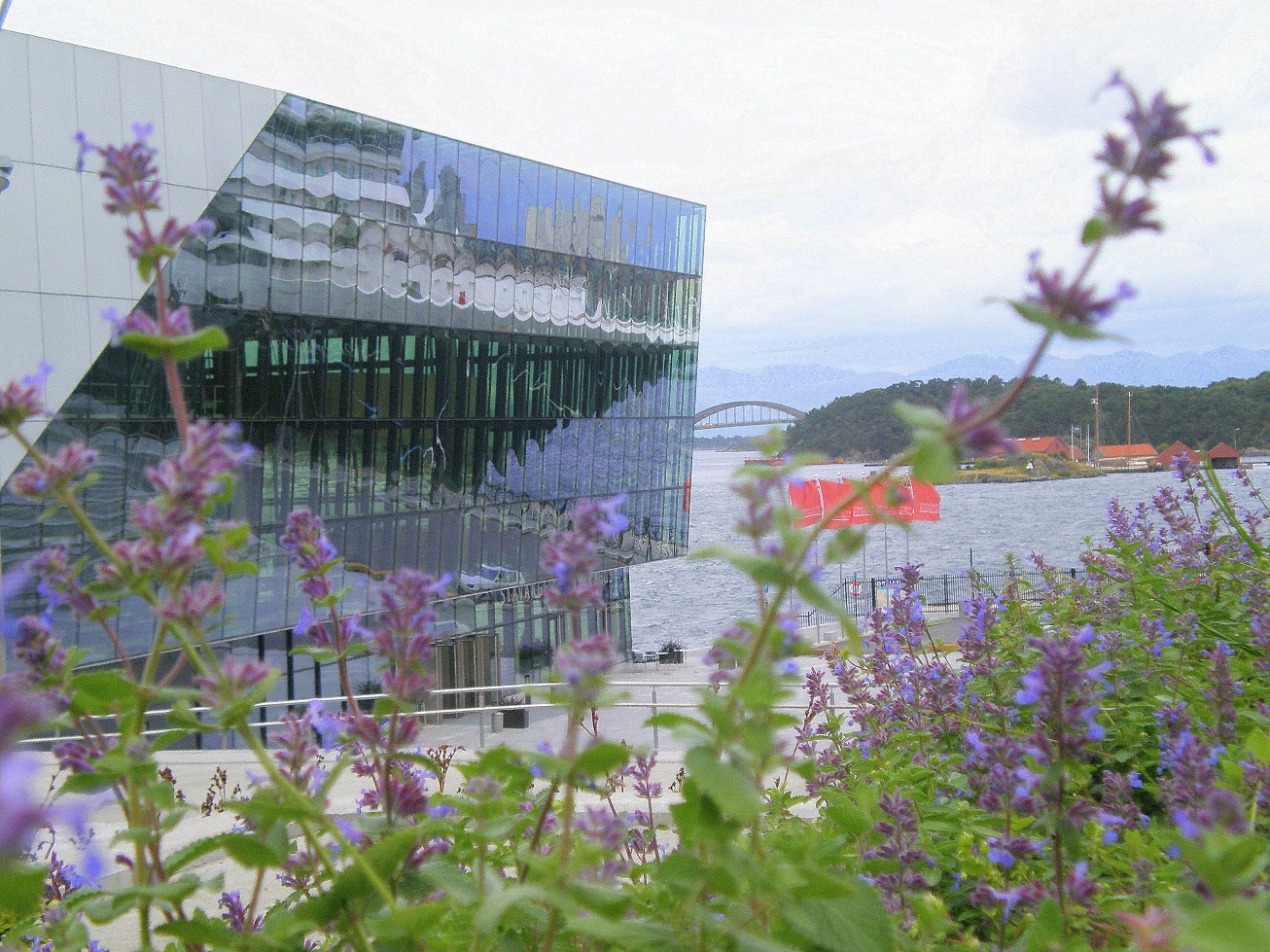 It was a mere ten minutes’ walk round a blustery harbour to the brand-new Stavanger concert hall hosting its first festival concert, a 1500-seater alongside a multipurpose hall with aspirations to being to Stavanger what the far showier Harpa is to Reykjavík. “I boks”, the name given to the building by the 2003 competition winner Medplan AS Arkitekter (now RATIO Arkitekter AS) of Oslo, means both "in a container" and "ready to go". It scores over Harpa in one crucial respect – the organ which Harpa lacks. This one is a beauty, built in Fredrikstad by Ryde and Berg, with 4554 pipes, 65 registers and 65,000 parts (yes, I had to look at my notes). I was lucky to hear it in action since maverick organist Gunnar Idenstam was practicing his transcription of Debussy’s La Mer due to take place in a concert happening after my departure.
It was a mere ten minutes’ walk round a blustery harbour to the brand-new Stavanger concert hall hosting its first festival concert, a 1500-seater alongside a multipurpose hall with aspirations to being to Stavanger what the far showier Harpa is to Reykjavík. “I boks”, the name given to the building by the 2003 competition winner Medplan AS Arkitekter (now RATIO Arkitekter AS) of Oslo, means both "in a container" and "ready to go". It scores over Harpa in one crucial respect – the organ which Harpa lacks. This one is a beauty, built in Fredrikstad by Ryde and Berg, with 4554 pipes, 65 registers and 65,000 parts (yes, I had to look at my notes). I was lucky to hear it in action since maverick organist Gunnar Idenstam was practicing his transcription of Debussy’s La Mer due to take place in a concert happening after my departure.
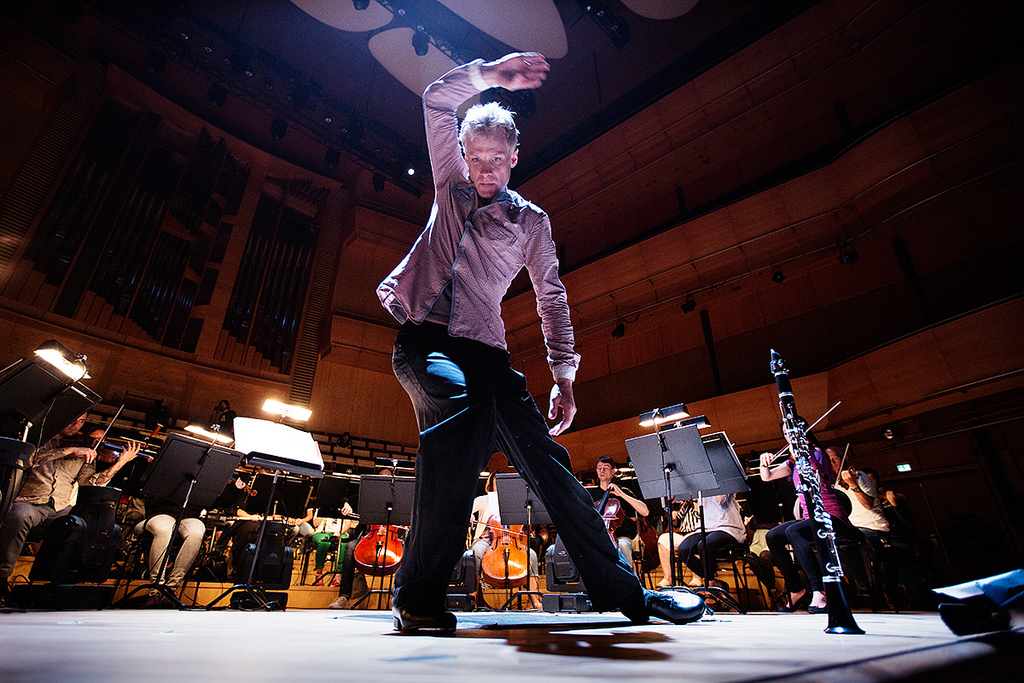 The evening concert in Fartein Valen, as the hall is named after the Stavanger-born composer, was a Fröst extravaganza incorporating the excellent Stavanger Symphony Orchestra, choreography and skilful lighting. Many of us have seen Fröst do his masked dance act; some question it, but it’s an accomplished expression of his disciplined theatricality, and how fluidly he switches from clarinet to marionette movements. Brother Göran’s new D-Tangled (Fröst pictured above) sounded a bit old-fashioned to me, but I was spellbound by Dane Bent Sørensen’s short Doll steps in Venice, a music-theatre piece with Fröst echoed by two other moving clarinettists. Best of all was the sublime segue into the haunting introduction of Dukas’s The Sorcerer’s Apprentice. I don’t think I’ve heard this scherzo-masterpiece since seeing Fantasia and going to Croydon children’s concerts as a kid, and the revelation was how disciplined and restrained Fröst is as a conductor, every tempo-change perfectly negotiated.
The evening concert in Fartein Valen, as the hall is named after the Stavanger-born composer, was a Fröst extravaganza incorporating the excellent Stavanger Symphony Orchestra, choreography and skilful lighting. Many of us have seen Fröst do his masked dance act; some question it, but it’s an accomplished expression of his disciplined theatricality, and how fluidly he switches from clarinet to marionette movements. Brother Göran’s new D-Tangled (Fröst pictured above) sounded a bit old-fashioned to me, but I was spellbound by Dane Bent Sørensen’s short Doll steps in Venice, a music-theatre piece with Fröst echoed by two other moving clarinettists. Best of all was the sublime segue into the haunting introduction of Dukas’s The Sorcerer’s Apprentice. I don’t think I’ve heard this scherzo-masterpiece since seeing Fantasia and going to Croydon children’s concerts as a kid, and the revelation was how disciplined and restrained Fröst is as a conductor, every tempo-change perfectly negotiated.
It was clever to choose Stravinsky’s Pulcinella Suite – look, no clarinets! – and it was deftly negotiated with superb instrumental solos from leader, oboe, trombone and well-intoned double bass. Perhaps the orchestra was a bit big to play Stravinsky’s chamber ensemble, but again Fröst's conducting credentials were remarkable and it all sounded very sleek indeed Then more clarinet-trio ghostliness, and the brilliant theatrics of Anders Hillborg’s Peacock Variations, a work Fröst has rightly championed.
There was further unexpected puppetry across the harbour when our tasting of an excellent buffet was diverted by a Pinocchio pastiche directed by volunteer doyenne Gaye Rosland, whose tireless lunches and suppers for musicians and special visitors made our stay possible from the eating point of view (at £15 for a bag of crisps, which incidentally I didn’t open, in the hotel room, you begin to understand why Norway, despite having the most dramatic scenery in Scandinavia, is not a viable option for many tourists). The volunteers are the circulating lifeblood of the festival – there were some 140 of them this year, and they make taking a festival taxi or having a ticket torn a special pleasure.
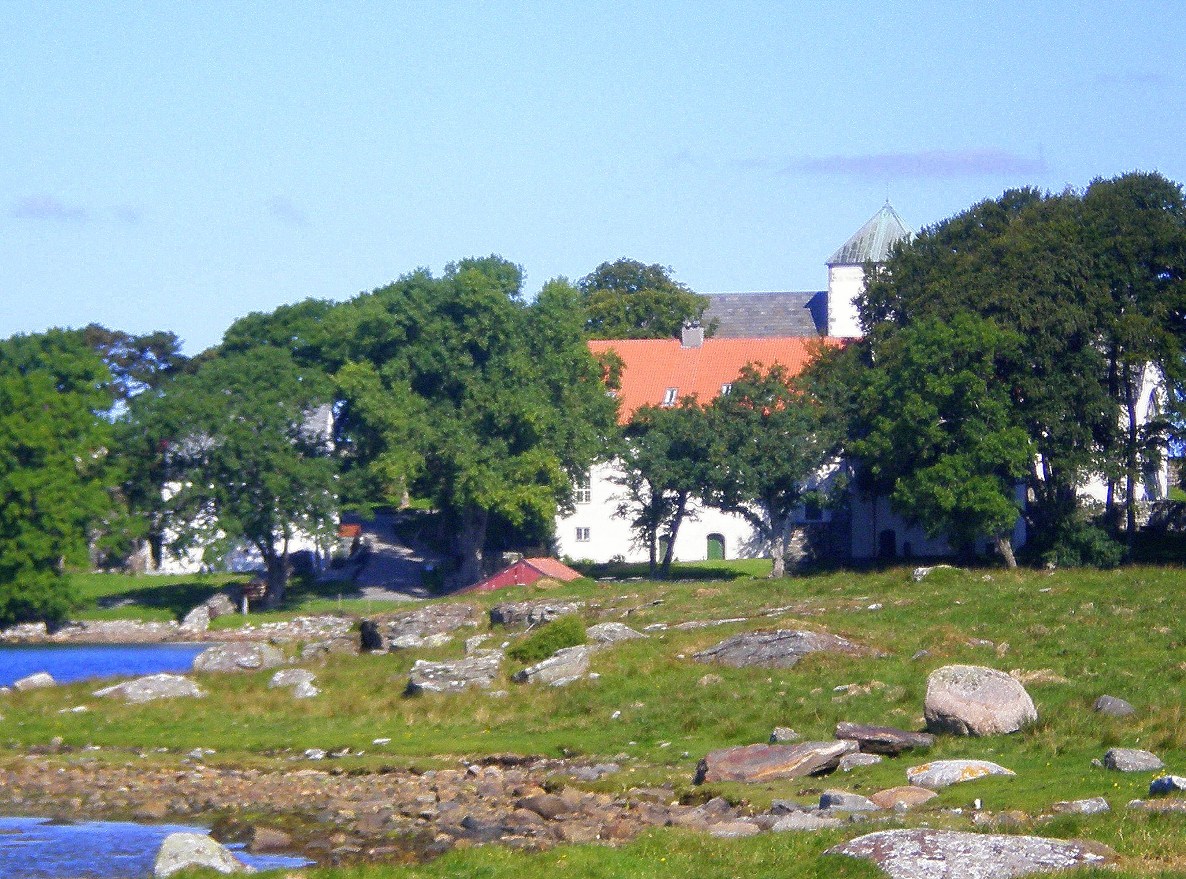 One big regret of leaving midway was that we weren’t going to catch the final concert in the very special venue of the 13th-century Utstein Monastery (pictured left), built on the foundations of a king’s residence and situated on the island of Fjøloy (reachable by road tunnel). My rather heavy hint that, given there was no time between concerts to travel up the fjord to more dramatic landscape, I’d like to see this historic building by the sea was taken up by Hanne Bernhardt Buvik, festival press officer, who drove us there. In a way, this was even better than sharing a festival picnic and concert with hundreds of other visitors; we had the church and the attached residential buildings to ourselves. And the water wasn’t too cold to take a dip in brilliant sunshine.
One big regret of leaving midway was that we weren’t going to catch the final concert in the very special venue of the 13th-century Utstein Monastery (pictured left), built on the foundations of a king’s residence and situated on the island of Fjøloy (reachable by road tunnel). My rather heavy hint that, given there was no time between concerts to travel up the fjord to more dramatic landscape, I’d like to see this historic building by the sea was taken up by Hanne Bernhardt Buvik, festival press officer, who drove us there. In a way, this was even better than sharing a festival picnic and concert with hundreds of other visitors; we had the church and the attached residential buildings to ourselves. And the water wasn’t too cold to take a dip in brilliant sunshine.
Rustic intermezzo over, the rest of the day was festival-packed. The lunchtime at Skur 2 embraced plenty of dancing – singing, too, from amiable Trpçeski as he took us through the folksongs woven into fellow Macedonian Pande Shahov’s little suite. His upper hand in Grieg’s Norwegian Dances in another four-hand arrangement may have made them sound a little, shall we say, Balkan, but the changes were rung as Hadland swapped seats with him halfway through. First acquaintance with violinist Sayaka Shoji, partnered by Olafsson in an arrangement of Bartók’s Romanian Folkdances, suggested plenty of character – but would she adapt to the demands of Brahms’s colossal G minor Piano Quartet that evening?
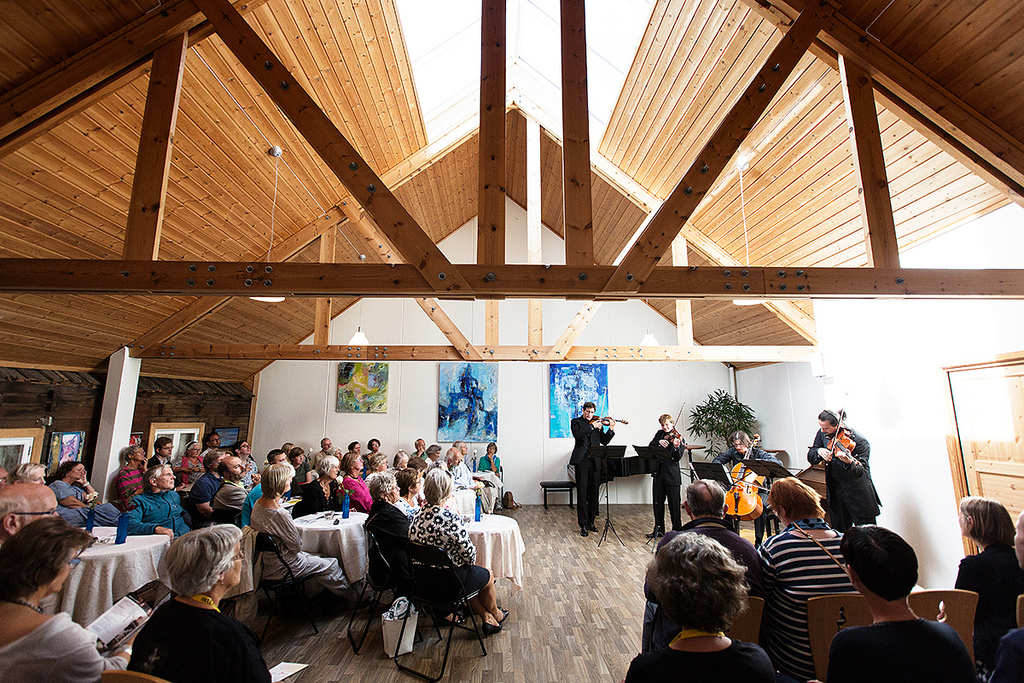 The question was postponed as we whizzed off to Sandnes, Stavanger’s slightly run-down neighbour judging from the part of town where Ivar Skei, the music shop run by Liv Reidun Gramstead – the lady I mentioned above – is situated. Nor was it quite clear from wandering the streets whether Norway’s sizeable immigrant community, here dominated by east Africans, really does have the chance to integrate. But we were here to witness more great players by way of a festival thank-you in Liv’s loft. Brilliant musicianship from Thorsen and Hedlund in a pleasant enough sonata by Trondheim-born 19th century composer Thomas Tellefsen warmed us up for concentrating in the afternoon attic heat on the Apollon Musagète Quartet’s performance of Shostakovich’s Fourth Quartet (pictured above). The fact that three of the four stand made total sense of the frenzies and the Jewish dance-music in the piece. And they scaled the vibrato and the individual personalities – unquestionably dominated by spellbinding violinist Pavel Zalejski – up or down according to context.
The question was postponed as we whizzed off to Sandnes, Stavanger’s slightly run-down neighbour judging from the part of town where Ivar Skei, the music shop run by Liv Reidun Gramstead – the lady I mentioned above – is situated. Nor was it quite clear from wandering the streets whether Norway’s sizeable immigrant community, here dominated by east Africans, really does have the chance to integrate. But we were here to witness more great players by way of a festival thank-you in Liv’s loft. Brilliant musicianship from Thorsen and Hedlund in a pleasant enough sonata by Trondheim-born 19th century composer Thomas Tellefsen warmed us up for concentrating in the afternoon attic heat on the Apollon Musagète Quartet’s performance of Shostakovich’s Fourth Quartet (pictured above). The fact that three of the four stand made total sense of the frenzies and the Jewish dance-music in the piece. And they scaled the vibrato and the individual personalities – unquestionably dominated by spellbinding violinist Pavel Zalejski – up or down according to context.
 This was the highlight for Mona Levin, heading back to Oslo after early supper. But it was if anything trumped by the quartet’s late-night cathedral performance of Janáček’s “Kreutzer Sonata” First Quartet, searing, battering and breaking our hearts against a backdrop of candles and surrounding darkness. And if we’re talking about scale and the ultimate challenge, the earlier performance of the Brahms towered over all. The late Valentin Berlinsky of the Borodin Quartet, who loved Stavanger, once talked to me about "festival quality", a disparaging term for performances by fine artists just thrown together. I’ve heard some such at Verbier. But on this occasion Shoji – who absolutely did adapt – Grosz as the quartet's strong core, Gustafsson and Hadland (Shoji, Grosz and Hadland pictured above), equal to all of Brahms’s epic-lyric demands, had that kind of telepathic split second synchonicity you dream about in chamber performances.
This was the highlight for Mona Levin, heading back to Oslo after early supper. But it was if anything trumped by the quartet’s late-night cathedral performance of Janáček’s “Kreutzer Sonata” First Quartet, searing, battering and breaking our hearts against a backdrop of candles and surrounding darkness. And if we’re talking about scale and the ultimate challenge, the earlier performance of the Brahms towered over all. The late Valentin Berlinsky of the Borodin Quartet, who loved Stavanger, once talked to me about "festival quality", a disparaging term for performances by fine artists just thrown together. I’ve heard some such at Verbier. But on this occasion Shoji – who absolutely did adapt – Grosz as the quartet's strong core, Gustafsson and Hadland (Shoji, Grosz and Hadland pictured above), equal to all of Brahms’s epic-lyric demands, had that kind of telepathic split second synchonicity you dream about in chamber performances.
Needless to say, there were also lashings of the wildness which was so much a part of this festival’s tumultuous dancing. Brahms’s gypsy rondo should crown it all, and in this once-in-a-lifetime performance it certainly did. I was still singing it in my head the next morning as the plane flew over a great glacier on the way from Bergen, our changing airport, to Stockholm and the next two-thirds of an August holiday in the north I'll never forget.
All artist images by Nikolaj Lund. Building shots by David Nice
- Christian Ihle Hadland plays Beethoven's Second Piano Concerto in Tuesday's Prom
- Read David Nice's blog, I'll Think of Something Later
Explore topics
Share this article
The future of Arts Journalism
You can stop theartsdesk.com closing!
We urgently need financing to survive. Our fundraising drive has thus far raised £49,000 but we need to reach £100,000 or we will be forced to close. Please contribute here: https://gofund.me/c3f6033d
And if you can forward this information to anyone who might assist, we’d be grateful.

Subscribe to theartsdesk.com
Thank you for continuing to read our work on theartsdesk.com. For unlimited access to every article in its entirety, including our archive of more than 15,000 pieces, we're asking for £5 per month or £40 per year. We feel it's a very good deal, and hope you do too.
To take a subscription now simply click here.
And if you're looking for that extra gift for a friend or family member, why not treat them to a theartsdesk.com gift subscription?
more Classical music
 Robin Holloway: Music's Odyssey review - lessons in composition
Broad and idiosyncratic survey of classical music is insightful but slightly indigestible
Robin Holloway: Music's Odyssey review - lessons in composition
Broad and idiosyncratic survey of classical music is insightful but slightly indigestible
 Classical CDs: Wolf-pelts, clowns and social realism
British ballet scores, 19th century cello works and contemporary piano etudes
Classical CDs: Wolf-pelts, clowns and social realism
British ballet scores, 19th century cello works and contemporary piano etudes
 Bizet in 150th anniversary year: rich and rare French offerings from Palazzetto Bru Zane
Specialists in French romantic music unveil a treasure trove both live and on disc
Bizet in 150th anniversary year: rich and rare French offerings from Palazzetto Bru Zane
Specialists in French romantic music unveil a treasure trove both live and on disc
 Scottish Chamber Orchestra, Ibragimova, Queen’s Hall, Edinburgh review - rarities, novelties and drumrolls
A pity the SCO didn't pick a better showcase for a shining guest artist
Scottish Chamber Orchestra, Ibragimova, Queen’s Hall, Edinburgh review - rarities, novelties and drumrolls
A pity the SCO didn't pick a better showcase for a shining guest artist
 Kilsby, Parkes, Sinfonia of London, Wilson, Barbican review - string things zing and sing in expert hands
British masterpieces for strings plus other-worldly tenor and horn - and a muscular rarity
Kilsby, Parkes, Sinfonia of London, Wilson, Barbican review - string things zing and sing in expert hands
British masterpieces for strings plus other-worldly tenor and horn - and a muscular rarity
 From Historical to Hip-Hop, Classically Black Music Festival, Kings Place review - a cluster of impressive stars for the future
From quasi-Mozartian elegance to the gritty humour of a kitchen inspection
From Historical to Hip-Hop, Classically Black Music Festival, Kings Place review - a cluster of impressive stars for the future
From quasi-Mozartian elegance to the gritty humour of a kitchen inspection
 Shibe, LSO, Adès, Barbican review - gaudy and glorious new music alongside serene Sibelius
Adès’s passion makes persuasive case for the music he loves, both new and old
Shibe, LSO, Adès, Barbican review - gaudy and glorious new music alongside serene Sibelius
Adès’s passion makes persuasive case for the music he loves, both new and old
 Anja Mittermüller, Richard Fu, Wigmore Hall review - a glorious hall debut
The Austrian mezzo shines - at the age of 22
Anja Mittermüller, Richard Fu, Wigmore Hall review - a glorious hall debut
The Austrian mezzo shines - at the age of 22
 First Person: clarinettist Oliver Pashley on the new horizons of The Hermes Experiment's latest album
Compositions by members of this unusual quartet feature for the first time
First Person: clarinettist Oliver Pashley on the new horizons of The Hermes Experiment's latest album
Compositions by members of this unusual quartet feature for the first time
 Gesualdo Passione, Les Arts Florissants, Amala Dior Company, Barbican review - inspired collaboration excavates the music's humanity
At times it was like watching an anarchic religious procession
Gesualdo Passione, Les Arts Florissants, Amala Dior Company, Barbican review - inspired collaboration excavates the music's humanity
At times it was like watching an anarchic religious procession
 Classical CDs: Camels, concrete and cabaret
An influential American composer's 90th birthday box, plus British piano concertos and a father-and-son duo
Classical CDs: Camels, concrete and cabaret
An influential American composer's 90th birthday box, plus British piano concertos and a father-and-son duo
 Cockerham, Manchester Camerata, Sheen, Martin Harris Centre, Manchester review - re-enacting the dawn of modernism
Two UK premieres added to three miniatures from a seminal event of January 1914
Cockerham, Manchester Camerata, Sheen, Martin Harris Centre, Manchester review - re-enacting the dawn of modernism
Two UK premieres added to three miniatures from a seminal event of January 1914

Add comment